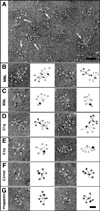Regulation of complement by cartilage oligomeric matrix protein allows for a novel molecular diagnostic principle in rheumatoid arthritis
- PMID: 20737467
- PMCID: PMC4576017
- DOI: 10.1002/art.27720
Regulation of complement by cartilage oligomeric matrix protein allows for a novel molecular diagnostic principle in rheumatoid arthritis
Abstract
Objective: Cartilage oligomeric matrix protein (COMP) is a structural component of cartilage, where it catalyzes collagen fibrillogenesis. Elevated amounts of COMP are found in serum during increased turnover of cartilage associated with active joint disease, such as rheumatoid arthritis (RA) and osteoarthritis (OA). This study was undertaken to investigate the ability of COMP to regulate complement, a capacity that has previously been shown for some other cartilage proteins.
Methods: Regulation of complement by COMP was studied using functional in vitro assays. Inter-actions between complement proteins and COMP were investigated by direct binding assay and electron microscopy. Circulating COMP and COMP-C3b complexes in serum and synovial fluid from RA and OA patients and healthy controls were measured with a novel enzyme-linked immunosorbent assay.
Results: We found in vivo evidence of complement activation by released COMP in the general circulation of patients with RA, but not patients with OA. COMP induced activation and deposition of C3b and C9 specifically via the alternative pathway of complement, which was attributable to direct interaction between COMP and properdin. Furthermore, COMP inhibited the classical and the lectin complement pathways due to direct interaction with the stalk region of C1q and mannose-binding lectin, respectively.
Conclusion: COMP is the first extracellular matrix protein for which an active role in inflammation has been demonstrated in vivo. It can activate one complement pathway at the same time as it has the potential to inhibit another. The net outcome of these interactions is most likely determined by the type of released COMP fragments, which may be disease specific.
Copyright © 2010 by the American College of Rheumatology.
Figures






Similar articles
-
[Cartilage oligomeric matrix protein (COMP): the role of a non-collagen cartilage matrix protein as a marker of disease activity and joint destruction in patients with rheumatoid arthritis and osteoarthritis].Z Rheumatol. 1999 Apr;58(2):79-87. doi: 10.1007/s003930050156. Z Rheumatol. 1999. PMID: 10408068 German.
-
Small fragments of cartilage oligomeric matrix protein in synovial fluid and serum as markers for cartilage degradation.Br J Rheumatol. 1997 Nov;36(11):1151-60. doi: 10.1093/rheumatology/36.11.1151. Br J Rheumatol. 1997. PMID: 9402858
-
Enhanced COMP catabolism detected in serum of patients with arthritis and animal disease models through a novel capture ELISA.Osteoarthritis Cartilage. 2012 Aug;20(8):854-62. doi: 10.1016/j.joca.2012.05.003. Epub 2012 May 14. Osteoarthritis Cartilage. 2012. PMID: 22595227 Free PMC article.
-
The role of cartilage oligomeric matrix protein (COMP) in skeletal disease.Curr Drug Targets. 2008 Oct;9(10):869-77. doi: 10.2174/138945008785909293. Curr Drug Targets. 2008. PMID: 18855621 Review.
-
Cartilage oligomeric matrix protein level in rheumatic diseases: potential use as a marker for measuring articular cartilage damage and/or the therapeutic efficacy of treatments.Ann N Y Acad Sci. 2007 Jun;1108:398-407. doi: 10.1196/annals.1422.041. Ann N Y Acad Sci. 2007. PMID: 17894003 Review.
Cited by
-
Synovium and the innate inflammatory network in osteoarthritis progression.Curr Rheumatol Rep. 2013 May;15(5):323. doi: 10.1007/s11926-013-0323-5. Curr Rheumatol Rep. 2013. PMID: 23516014 Free PMC article. Review.
-
The different roles of aggrecan interaction domains.J Histochem Cytochem. 2012 Dec;60(12):987-96. doi: 10.1369/0022155412464376. Epub 2012 Sep 26. J Histochem Cytochem. 2012. PMID: 23019016 Free PMC article. Review.
-
Complement in the immunopathogenesis of rheumatic disease.Nat Rev Rheumatol. 2012 Aug;8(8):458-68. doi: 10.1038/nrrheum.2012.75. Epub 2012 Jun 5. Nat Rev Rheumatol. 2012. PMID: 22664835 Review.
-
Factor H autoantibodies and deletion of Complement Factor H-Related protein-1 in rheumatic diseases in comparison to atypical hemolytic uremic syndrome.Arthritis Res Ther. 2012 Aug 15;14(4):R185. doi: 10.1186/ar4016. Arthritis Res Ther. 2012. PMID: 22894814 Free PMC article.
-
The role of innate immunity in osteoarthritis: when our first line of defense goes on the offensive.J Rheumatol. 2015 Mar;42(3):363-71. doi: 10.3899/jrheum.140382. Epub 2015 Jan 15. J Rheumatol. 2015. PMID: 25593231 Free PMC article. Review.
References
-
- Hedbom E, Antonsson P, Hjerpe A, Aeschlimann D, Paulsson M, Rosa-Pimentel E, et al. Cartilage matrix proteins. An acidic oligomeric protein (COMP) detected only in cartilage. J Biol Chem. 1992;267(9):6132–6136. - PubMed
-
- Smith RK, Zunino L, Webbon PM, Heinegård D. The distribution of cartilage oligomeric matrix protein (COMP) in tendon and its variation with tendon site, age and load. Matrix Biol. 1997;16(5):255–271. - PubMed
-
- DiCesare P, Hauser N, Lehman D, Pasumarti S, Paulsson M. Cartilage oligomeric matrix protein (COMP) is an abundant component of tendon. FEBS Lett. 1994;354(2):237–240. - PubMed
-
- Dodge GR, Hawkins D, Boesler E, Sakai L, Jimenez SA. Production of cartilage oligomeric matrix protein (COMP) by cultured human dermal and synovial fibroblasts. Osteoarthritis Cartilage. 1998;6(6):435–440. - PubMed
-
- Saxne T, Heinegård D. Cartilage oligomeric matrix protein: a novel marker of cartilage turnover detectable in synovial fluid and blood. Br J Rheumatol. 1992;31(9):583–591. - PubMed
Publication types
MeSH terms
Substances
Grants and funding
LinkOut - more resources
Full Text Sources
Other Literature Sources
Medical
Research Materials
Miscellaneous

